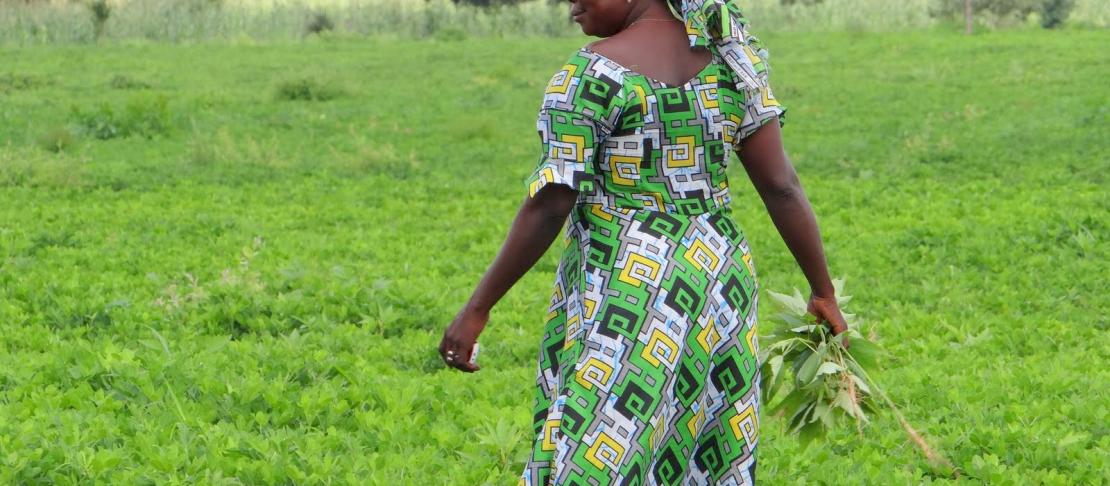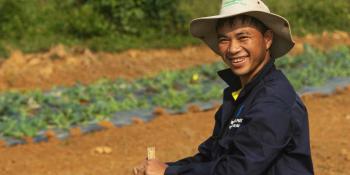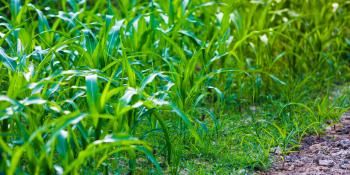The impact of climate information services in Senegal

Key findings
- CCAFS scientists collaborated with the Senegalese National Meteorological Agency to develop downscaled climate information services and enhance the capacity of partners who are tasked to communicate climate information to farmers.
- As of August 2015, seasonal forecasts are transmitted nationwide through 82 rural community radio stations and SMS, potentially reaching 7.4 million rural people across Senegal.
- Climate information in Senegal is now considered an agricultural input just like seeds, fertilizers and equipment, which are at the basis of production.
- Common uses of CI in the project areas were changes in sowing date and crop variety
Summary
Seasonal rainfall forecasts can help farmers adapt to climate change and improve their resilience to climate shocks. The CGIAR Research Program on Climate Change, Agriculture and Food Security (CCAFS) collaborated with the Senegalese National Meteorological Agency (ANACIM) to develop climate information (CI) services that are relevant to farmers on a broad scale. Farmers have been involved in every step of the process, helping meteorologists and other specialists package and communicate climate information. This study investigates how many farmers have access to climate information in Senegal as well as the impact of the information on farmers’ practices.
Background
Senegal has a predominantly rural economy where rainfall is the most decisive factor of production. The country’s strong dependence on rainfed agriculture makes it highly vulnerable to climate change. Variability of rainfall is a major constraint to agricultural sustainability in Senegal. Since climate change will aggravate this problem, using seasonal climate forecasts to inform farmers, will be necessary to make better use of rainwater and to facilitate decision-making.
A survey conducted by the National Civil Aviation and Meteorology Agency of Senegal (ANACIM) showed good predictability of rainfall in the Sahel and therefore the possibility of establishing a warning system to cope with climate uncertainties (Ndiaye et al. 2011). This is why ANACIM together with CCAFS and other partners initiated a project to enhance the transmission of climate information and agricultural advice for farmers in Senegal.
The pilot project was implemented in Kaffrine in 2011 and later expanded to Diourbel, Fatick, Louga and Thies regions. By 2015, the project had scaled up to the rest of the country through a partnership with the Union des Radios Associatives et Communautaires du Sénégal (URACS), an association of 82 community-based radio stations.
Kaffrine, the epicentre of the project, is located in the transition zone between the Sahel and the SudanoSahel zone. The selection of Kaffrine is justified by its strategic location in the groundnut basin, the high interannual variability of rainfall, and the results of a household survey conducted in 2011 which provided basic information on food security, vulnerability of farmers, and the level of CI availability (Kristjanson et al. 2011). The survey revealed that farmers in Kaffrine did not use seasonal forecasts; instead they relied on traditional knowledge to predict the weather and seasonal trends. It was clear that in order to convince farmers of the benefits of CI, the project would have to first build trust with the farming community. (Ndiaye et al. 2013).
CCAFS used a multi-disciplinary group model to provide a platform for stakeholders to put their heads together. These multi-disciplinary teams consisted of farmers; climatologists; agricultural scientists, extension agents, NGOs, and the media and provided an open space for dialogue. During the pilot, farmers explained to the scientists how they traditionally interpret natural signs in order to predict the onset of the rainy season. The scientists were able to show the farmers how their indigenous knowledge linked with the technical weather forecasts. Integrating traditional forecasting methods with scientific forecasting provided insights into knowledge gaps at the local level and increased farmers’ trust in scientific forecasting. Farmers were given the opportunity to indicate their specific climate information needs as well as the way they would like to receive climate information. (Ndiaye et al. 2013; Jay 2014; Lo and Dieng 2015)
Capacity enhancement workshops were organized in the different project areas to:
- sensitize local stakeholders on the importance of CI in decision making;
- familiarize local stakeholders with weather forecasting and the jargon used by forecasters.
Effective climate information services rely upon locally relevant climate data tailored to farmers’ needs. A study on women’s vulnerability and needs with respect to climate change in Kaffrine revealed that men and women had different climate information needs. Although women had their own plots to cultivate, their male counterparts controlled the production inputs. As a result, women planted and harvested much later in the season than men. This is why the onset date of the rainy season is more important to male farmers and the date of seasonal rainfall cessation more useful to women. (Ndiaye et al. 2013; Tall et al. 2014).
CCAFS estimated the number of CI users to be two million in 2013. (CCAFS 2013)
Scope and methods
In 2014, a study was undertaken to confirm or deny the probability of the figures put forward by CCAFS (two million CI users in 2013) and to analyse the use of this information, as well as the impact on farmers’ practices and behavior (Lo and Dieng 2015). The methodologies used include gathering information through interviews with relevant stakeholders, targeted surveys, mapping and review of project reports.
Stage 1: Review of secondary data and preparation of data collection instruments
- mapping of stakeholders;
- literature review (population data, statistics and project reports;
- development of data collection tools targeted at community radios, farmers and farmer organizations, and rural development technical services.
Stage 2: Estimation of the number of people with access to CI
- mapping of community radio stations that broadcast CI in the project intervention sites;
- development of interview guides to identify potential channels of information dissemination.
Stage 3: Analysis of the impacts of CI use
- interviews with decentralized administrative and technical services in charge of agricultural and rural development;
- interviews with farmers;
- interviews with platform partners (agricultural cooperatives, NGOs, Local Red Cross, etc.).
Stage 4: Information processing and analysis
The data collected was processed using MS Word and Excel. The radio stations’ location map was produced with ArcGiS. The information analysis helped to:
- document the strengths and weaknesses of the CI dissemination process,
- identify opportunities for upscaling;
- make recommendations for the coming years.
Findings
CI PRODUCTION
ANACIM produces four types of CI. These different types of information form the basis of advice provided to farmers to cope with all the uncertainties associated with the rainy season. Forecast models to predict the onset of the rainy season are developed in partnership with AGRHYMET. (Lo and Dieng 2015)
1. Seasonal forecasts
Seasonal forecasts give the overall configuration of the rainy season. At the end of May, ANACIM experts observe trends for the coming season and label them: rainy, normal or deficit. If the forecast shows that the season will be in deficit, a warning report is transmitted to government authorities to take appropriate action. The seasonal forecasts are updated at the beginning of June, July and August and translated into agricultural advice by the multidisciplinary working group (MWG). The national MWG is composed of the Department of Agriculture (DA), the Institute of Agricultural Research of Senegal (ISRA), the Ecological Monitoring Center (CSE), the National Agricultural and Rural Council Agency (ANCAR), the National Agricultural Insurance Company of Senegal (CNAAS), and ANACIM.
2. 10-day forecasts
When the rainy season sets in, ANACIM produces ten-day forecasts that help to identify dry spells and other anomalies in the distribution of rainfall in the project intervention areas. These 10-day forecasts are provided to enable the local MWGs, which meet every 10 days, to identify major trends in rainfall and provide appropriate guidance to farmers.
3. Daily forecasts
Since climate information is a perishable commodity that can become quickly obsolete, two weather reports are produced each day by ANACIM during the rainy season and downscaled for the project regions.
4. Instant forecasts for extreme events
The instant information concerns off-season showers or rains, high winds, and especially lightning (during the rainy season) which quite often decimates livestock. At ANACIM, an early warning system (EWS) has been put in place to give forecasts on risks of lightning, more than 4 hours in advance.
CI DISSEMINATION
Seasonal forecasts must reach remote rural communities in time for farmers to make use of them. ANACIM produces CI during the rainy season and is responsible for transmitting it directly to the MWG, rural radios, the Rural Development Departmental Services (SDDR) and farmers. In addition, ANACIM organizes a seminar at the beginning of each rainy season to inform farmers of the major trends. The seminar is also an opportunity to collect farmers’ forecasts based on their traditional knowledge.
At the very beginning of the project, climate information was disseminated in Kaffrine by the SDDR. Following an internal evaluation conducted in 2011, the farmers suggested to use community radio stations to disseminate CI since they have a large audience in rural areas.
In 2012, ANACIM signed a collaboration agreement with the Union des Radios Associatives et Communautaires du Sénégal (URACS). These stations operate in Senegal’s local languages. The radio programs are interactive and farmers are able to provide feedback. Capacity enhancement workshops were organized to enable radio broadcasters to easily understand and assume ownership of the jargon used by ANACIM forecasters.
While rural radio proved to be an important communication pathway for men, it was found that women often receive climate information through personal contacts at strategic places such as local boreholes where they gather water every day.
Farmers also play an active role in the dissemination of CI within their community. Through their network of social relationships, they facilitate access to CI for other farmers. A study conducted in the project areas revealed that individuals who did not have a strong social network were less likely to receive climate information and therefore could not take proactive steps to alleviate negative impacts of climate change. (Lynagh et al. 2014; D’Auria Ryley 2014)
Apart from radio, SMS is widely used for CI dissemination. The very broad cellular coverage allows for access in rural areas. In every rural household, there is at least one mobile phone, which is often used by many people. When farmers and extension agents receive climate information, they relay it to other farmers by SMS. This creates a multibranching distribution chain. Instant information is usually disseminated through this channel.
The extension agents are at the center of the entire dissemination system. They receive the CI via SMS from ANACIM and relay this to the village level through SMS, phone calls or “word of mouth”. Their interpretation of the forecast and related advice on fertilizer use, pesticide application, seed selection, etc. renders the CI actionable.
Through a combination of these different channels, between 2011 and 2014, up to 3.9 million rural people (not all farmers) were potentially reached with climate information in the project areas (Lo and Dieng 2015).
Indeed, the widespread use and coverage of mobile phones and radio have made it possible to convey climate information to a very large audience and to upscale the project to the rest of the country. In 2015 a total of 7.4 million rural people (not all farmers) among which there are about 740,000 agricultural households, were potentially reached with climate information across all 14 administrative regions of Senegal, via 82 rural community radios and SMS. (ANSD 2013; CCAFS 2015)
THE USE OF CLIMATE INFORMATION
Receiving climate information is one thing, but putting it into practice is another. In the beginning, the project witnessed resistance from many farmers who were accustomed to basing their actions only on their empirical knowledge. However, the project’s willingness to facilitate the integration of local knowledge in CI greatly helped to convince reluctant farmers. Today, farmers are no longer contented to wait for CI, but go in search of it.
Knowledge of the starting date of the rainy season greatly influences the cropping calendar. Previously, for example, the dry sowing of millet was common practice in the groundnut basin. In case of dry spells, the first seedlings were lost, forcing farmers into debt to purchase new seeds.
The substitution of certain crops with others is also a key change in farming practices. In 2014, many farmers substituted maize, which requires much rainfall, with soya bean and sesame, because of a low to normal rainfall forecast.
Access to CI also helps to streamline spending and labour. Farmers avoid wasting fertilizer in response to an announced rain as well as time on weeding and tilling, which could lead to erosion.
Starting the crop year requires resource mobilization to purchase agricultural inputs. Some farmers assessed their debt capacity for the crop year based on the seasonal forecasts.
At national level, CI is now considered as an agricultural input. Seasonal forecasts are communicated by the Minister of Agriculture in the Council of Ministers before the start of the crop year. Based on these forecasts, the Head of State and Government decide on what actions to take.
Conclusions
CI is made available through a combination of distribution channels that are accessible to rural populations. While at start-up the project estimated that community radios were the best medium to disseminate CI and agricultural advice, the use of SMS has considerably expanded access to CI.
An impact study covering the pilot project (5 administrative regions in Senegal) found that between 2011 and 2014, up to 3.9 million rural people (not all farmers) were potentially reached with climate information (Lo and Dieng 2015). According to the last population census, this is equivalent to about 236 937 rural agricultural households (ANSD 2013).
A partnership with the l’Union des Radios Associatives et Communautaires du Sénégal (URACS), a nationwide network of 82 rural community radios that broadcast in Senegal’s local languages has made it possible to upscale the project to all 14 administrative regions of Senegal. In August 2015, a case study conducted by CCAFS for DFID estimated that a total of 7.4 million rural people (not all farmers) were potentially reached with climate information across the country. (CCAFS 2015).
The adoption level of the farmers is clear – CI is now regarded as a primary agricultural input. Common forecast uses by farmers are: altering crop varieties and planting dates. Climate information is most useful when farmers have access to appropriate response options such as a good crop variety map and quality seeds.
Recommendations
- Involve more national radios to supplement community radios with low coverage radius.
- Identify and involve all voice carriers in the CI dissemination process.
- Conduct radio rating surveys in the project areas.
- Ensure timely dispatch of weather reports and use appropriate dissemination channels for various types of stakeholders.
- Produce and disseminate CI in the dry season.
- Increase the number of test farms and develop a formal strategy for replication at national level.
- Sensitize climate-related financial and insurance institutions for greater involvement in the process.
- Strengthen the extension agents network to facilitate CI dissemination.
- Expand the local MWG for better representation of the various localities and stakeholders, particularly women.
Management response
In its 2013 Technical Report to CCAFS, the CCAFS West Africa regional program reported that in Senegal, 15 rural radios scaled-up seasonal rainfall forecasts to their audience farmers in 4 administrative regions, reaching an estimated 2 million users. An impact assessment, Lo and Dieng (2015) was commissioned to assess the proportion of farmers that received access to Climate Information Services (CIS) and the impact of CIS on farmers’ decisions and behavior.
The study concludes that through different channels, 3.9 million rural people (not all farmers) were potentially reached in project areas between 2011 and 2014. ClS delivered multiple benefits to farmers: helped streamline spending and labour on the farm, change sowing dates, change crop varieties etc. The multiple benefits of CIS has now led to the Ministry of Agriculture considering CIS as an essential agricultural input. CCAFS management takes cognizance of valuable lessons in upscaling, partnerships, dissemination, and use of indigenous knowledge generated by this work, and continues to focus on further upscaling and sharing of these lessons with other countries, notably Colombia.
References
- ANSD. 2013. Rapport Definitif RGPHAE 2013. Agence Nationale de la Statistique et de la Démographie (ANSD).
- CCAFS. 2013. Scaling up seasonal forecasts to over 2 million users in Senegal. CCAFS.
- CCAFS. 2015. Scaling up climate advisories in Senegal and Colombia.
- D’Auria Ryley T and McKune S. 2014. Climate change and social networks in Senegal’s peanut basin. CCAFS.
- Jay. A. 2014. How can we turn climate information into action? Copenhagen: CCAFS.
- Kristjanson P, Garlick C, Ochieng S, Förch W, Thornton PK. 2011. Global Summary of Baseline Household Survey Results. CGIAR Research Program on Climate Change, Agriculture and Food Security (CCAFS). Copenhagen: Denmark.
- Lo HM and Dieng M. 2015. Impact assessment of communicating seasonal climate forecasts in Kaffrine, Diourbel, Louga, Thies and Fatick (niakhar) regions in Senegal. CCAFS.
- Lynagh S, Tall A, and Jay A. 2014. One size does not fit all: considering gender, equity and power in climate information services. CCAFS.
- Ndiaye O. 2011. Predictability of seasonal Sahel rainfall beyond the spring barrier using GCM MOS correction. Agence Nationale de la Meteorologie du Senegal (ANACIM).
- Ndiaye O, Moussa A, Seck M, Zougmoré R and Hansen J. 2013. Communicating seasonal forecasts to farmers in Kaffrine, Senegal for better agricultural management. In: Hunger – Nutrition – Climate Justice 2013. A New Dialogue: Putting People at the Heart of Global Development. Conference Papers. Dublin: Irish Aid.


